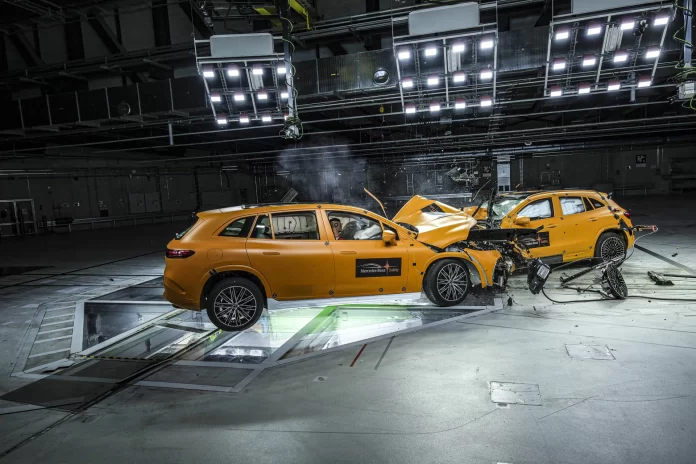Mercedes Vision an Accident Free Future, setting a goal to achieve zero car crashes by 2050. in order to create a future with enhanced safety. The automaker recently conducted the first known crash test between two electric vehicles, demonstrating its commitment to this vision.
This crash test, which was observed by journalists, was loud and violent, as expected. It involved an EQS SUV and EQA crossover SUV colliding head-on with a 50% frontal overlap, both traveling at 35 mph (56 kph). It’s important to note that this scenario goes beyond the requirements of standardized crash tests conducted by safety agencies.
Although both vehicles were completely destroyed in the crash, the passenger cells and high voltage battery packs remained intact. This means that the electric vehicles performed just as well in terms of safety as traditional fuel powered Mercedes-Benz vehicles.
Mercedes-Benz plans to continue its crash testing by conducting a roof crush test on the wrecked EQS SUV. This test will assess the vehicle’s ability to withstand damage to its roof, as only the front end was affected in the previous test.
Overall, this crash test represents an important step for Mercedes-Benz as it prepares for the future of electric vehicles and their safety capabilities.
Achieving a Future without Car Crashes
Mercedes vision for an accident free future is the ultimate goal, and reduce crashes to zero. It remains uncertain whether this can be fully achieved. According to Paul Dick, the Director of Vehicle Safety at Mercedes-Benz, there are currently 1.3 million road fatalities worldwide each year, equivalent to the population of 12 large airplanes. Mercedes-Benz aims to ensure none of its vehicles are involved in accidents by 2050. However, this goal may face challenges considering the presence of mixed vehicles driven by both humans and automated systems.
Julien Richert, responsible for Mercedes-Benz’s ESF program, which explores new designs and technologies for vehicle safety, acknowledges that even in an autonomous world, there will always be factors beyond control that can lead to accidents. For instance, unexpected incidents such as a falling tree limb may occur. Therefore, future vehicles will need to effectively communicate with their surroundings, including pedestrians and other drivers. Mercedes-Benz is experimenting with ways to achieve this, such as using teal-colored lighting on vehicles to indicate their autonomous mode. In the future, this communication could extend to windows that display graphics or provide live image feeds.
In preparation for this autonomous future, Mercedes-Benz’s ESF 2019 concept incorporated many of these potential safety features. It also introduced a different seating position for autonomous driving, with the seatbelt integrated into the seat rather than mounted on the pillars as in most current vehicles.
Current Crash Handling Measures
Currently, Mercedes-Benz employs a four phase approach to handle crash situations, regardless of whether the vehicle is powered by gas or electricity.
The first phase is the assistance phase, where active safety technologies like adaptive cruise control, blind spot monitors, automatic emergency braking, and the hands-free autonomous Drive Pilot system are utilized.
The second phase is the preparation phase, which comes into play when the vehicle’s sensors detect an imminent collision. In this phase, the windows roll up, seatbelt tensioners tighten, airbags pre charge to prepare for deployment, and if equipped with air or hydraulic suspension, the vehicle raises the side about to experience impact to move occupants away from the energy force.
The third phase is the protect phase, where all the vehicle’s airbags deploy. For example, the 2021 S-Class introduced a rear airbag mounted on the front seat backs for rear seat passengers. This concept was originally introduced in the ESF 2019 concept and later incorporated into production vehicles.
The final phase is the help phase, which involves alerting others the vehicle has been involved in an accident. This phase includes activation of hazard lights, shut down of the high voltage system in electric vehicles. It can also make a call to an emergency call center where operators are available assist.
The Black Box Recorder Now Yellow
All their vehicles are equipped with a black box (colored yellow) located at the center of the vehicle. This recording device serving as the central control unit for safety systems. In the event of a crash, Mercedes can retrieve data from this black box for analysis and investigation.
As Mercedes-Benz continues to produce both fuel and electric vehicles, the recent crash test signifies its commitment to safety. Continuingly testing as it develops its electric lineup and a future with fewer accidents.
